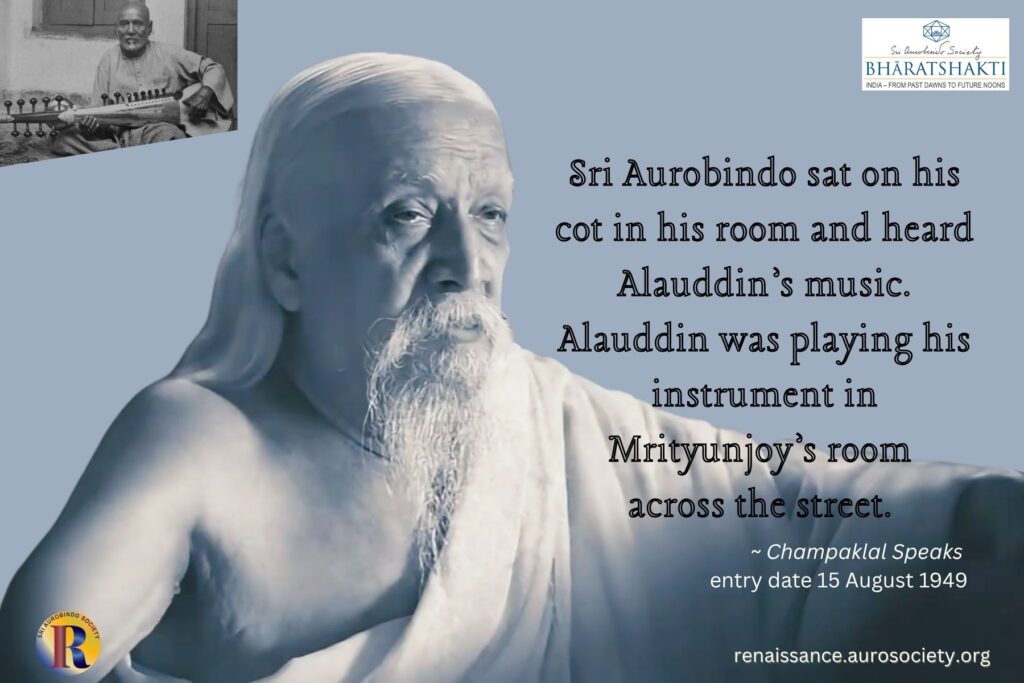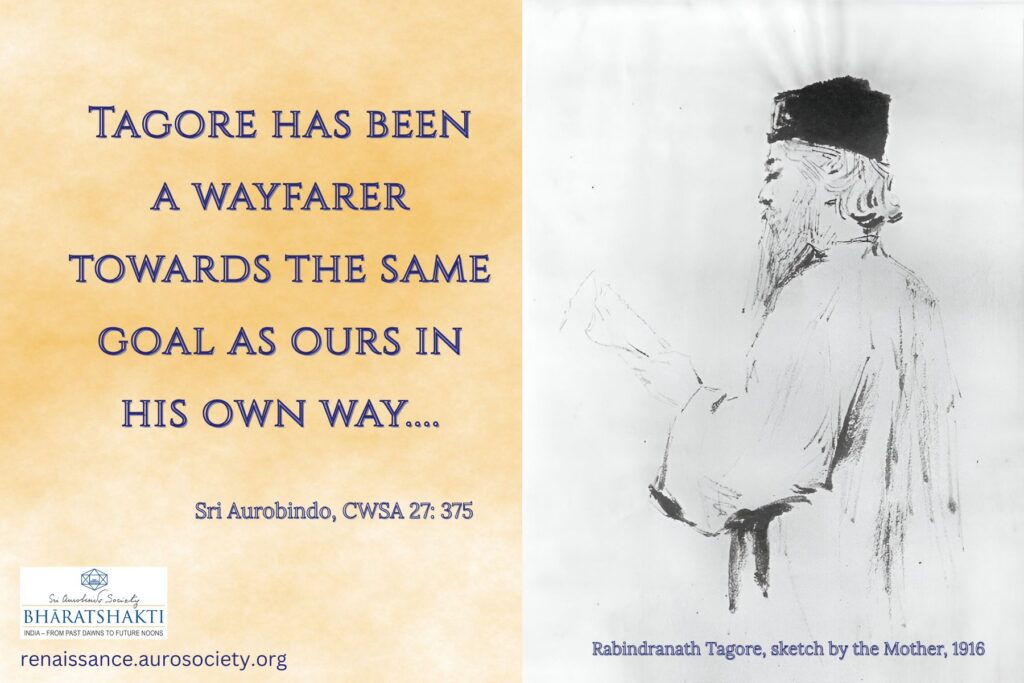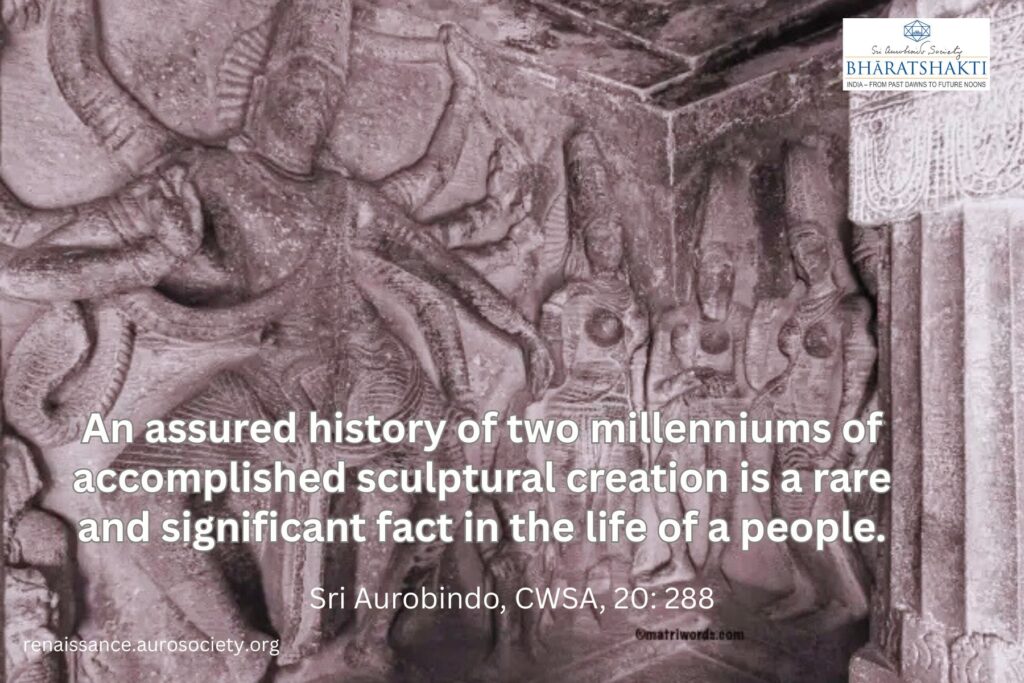Volume V, Issue 1
Author: Pradip Bhattacharya
Editor’s Note: The author helps us understand the deep symbolism behind the story of Daksha Prajapati’s head being severed, and his acquiring the head of a goat. This was first published in Mother India, Vol. LV, No. 10, October 2002, pp. 895-898, under the title Daksha and Kali. We have made a few minor formatting revisions for the purpose of this digital presentation.

More than thirty years ago, intrigued by some peculiar myths recounted in the Adi Parva of the Mahabharata, I had turned to my father who referred me to Sri Aurobindo’s The Secret of the Veda. This inspired me to explore the meanings hidden in the stories of Uttanka, Aruni, Upamanyu, the churning of the ocean, Garuda and Kacha1. Manoj Das’s recent talk published in Invocation swept me back into that engrossing weltanschauung.2
While talking about the mythic background of Savitri, he provides a brilliant insight towards the end regarding the inscrutable enigma of the Sphinx that has fascinated and intrigued mankind over the millennia. But that is not what set off my train of thought.
Re-reading the text, I was riveted by the explanation he provides of the much-debated, puzzling image of Kāli stepping on Shiva3 as a dyadic symbol representing the dialectical relationship between Time and Eternity:
Kāli is the prakriti bound to time, with one leg raised, in eternal movement, wearing human heads as a garland representing all the destruction and creation that goes on. And she is dark because…bound to this space and time, we do not know where we are going to place the next step, we do not know whether we will stand or if we are going to fall down; so her whole movement, which is a precise rendition of what is to come, remains veiled from our knowledge. Hence the image of dark time as a dynamic posture of Kāli, marching forward, firmly founded on eternity.
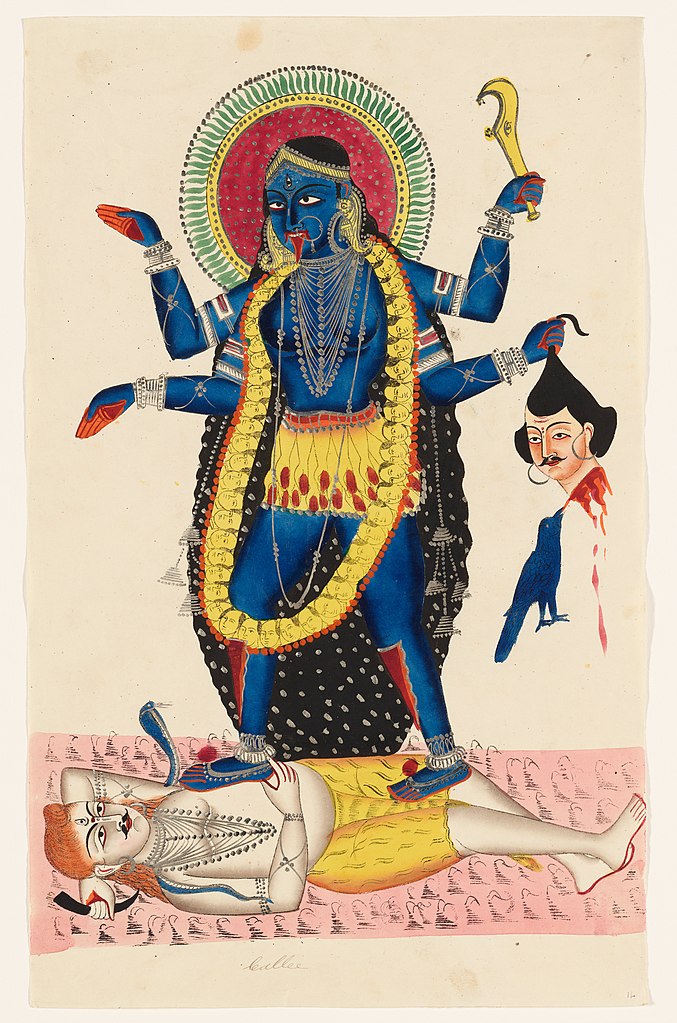
Where does Kāli first appear?
She is one of the ten terrifying emanations, mahāvidyās, Sati figures forth when Shiva refuses to let her attend her father Daksha’s yajña. That is when he reluctantly agrees. We know what happens thereafter: unable to countenance her father’s gross insult, Sati consumes herself in a supreme holocaust whereupon Shiva’s hordes rout the gods and rishis attending the ritual and decapitate Daksha. Does this hold any meaning for us, or is it just another of those “time-pass” myths for the illiterate masses?
What does daksha mean?
Let us go to the root, as Sri Aurobindo has shown us in his Vedic researches. It shares the same root as “dexterity,” the Latin dexter, “on the right” (significantly, Daksha is born of Brahma’s right thumb) and has the same meaning, “skilful.” As usual, however, the Sanskrit has a subtler sense: “clever, intelligent, mental power, strength of will, energy” (Monier-Williams’ Sanskrit-English Dictionary). It is not merely manual skill but the mind’s powers that are signified.
Daksha was declared as “Prajapati”, lord of creatures, by Brahma the creator, as Adam was by Jehovah. His overlordship sprouted a swiftly waxing arrogance that denied any superior. The Mother says about the first emanation of the Supreme Mother:
“In the sense and the feeling of (his) supreme power, (he) cut connection with (his) Origin and…being separated from (his) Origin, entered into darkness. The first one was Consciousness, Consciousness in Light, and by cutting Himself from His Origin, He went down and down towards Unconsciousness…This happened after (he) came down into the vital level.”4
ALSO READ:
The Gods and Goddess of the Veda
The mythology of Daksha, “A power of fallen boundless self”5 records this descent into the vital too. Rishi Durvasa visited Daksha wearing goddess Jagadambika’s amrita-oozing garland that she had gifted him. Noticing Daksha’s eagerness to possess it, the sage gave it to him. Placing the garland in his bedroom, excited by its wondrous fragrance, Daksha made love to his wife, polluting its purity. Upbraided for this by Sati and Shiva, he nursed a grudge against them. For the pauper and skull-carrying Shiva, Daksha had nothing but disgust and never forgave his daughter Sati for wedding him.
Once, when Daksha reached a sacrificial ceremony, he noticed that his son-in-law Shiva remained seated instead of rising to honour him. Considering himself grossly insulted, Daksha organised the Brihaspatisavana, a sacrificial ritual of heroic proportions to celebrate his glory, to which he invited all notables except Sati and Shiva.
Man, set above all creatures by the mind, gets so enamoured of his intellect’s powers that he brushes aside as inconsequential Prakriti and Purusha, regarding them as mental creations of the feeble-minded, made in his own image. He believes that there is nothing beyond material existence and achieving the acme of material excellence, acquiring wealth and power and becoming the master of the world as he sees it. Myth knows of him by many names: the Aloadaes, Nimrod, Kamalaksha-Tarakaksha-Vidyunmali, Lucifer.
READ:
Deva and Asura in the Bhagavad Gita
Striving to storm heaven, piling Ossa on Pelion, they build towering structures, magnificent edifices, great cities mocking the heavens: the Tower of Babel, Tripura—the triple cities of gold, silver and iron—Pandemonium, Leningrad/Stalingrad, the World Trade Centre. Divinity is denied, spiritual life scoffed at and sought to be ground under heel by state power. The Senecan tragic hero’s ominous mark of Cain is stamped upon man: “I am myself, alone.”
I climb, a claimant to the throne of heaven […]
~ Sri Aurobindo, Savitri, CWSA, Vol. 34, pp. 511, 518-519
I am God still unevolved in human form;
I have seized the cosmic energies for my use.
I have pored on her infinitesimal elements
And her invisible atoms have unmasked […]
If God is at work his secrets I have found.
***
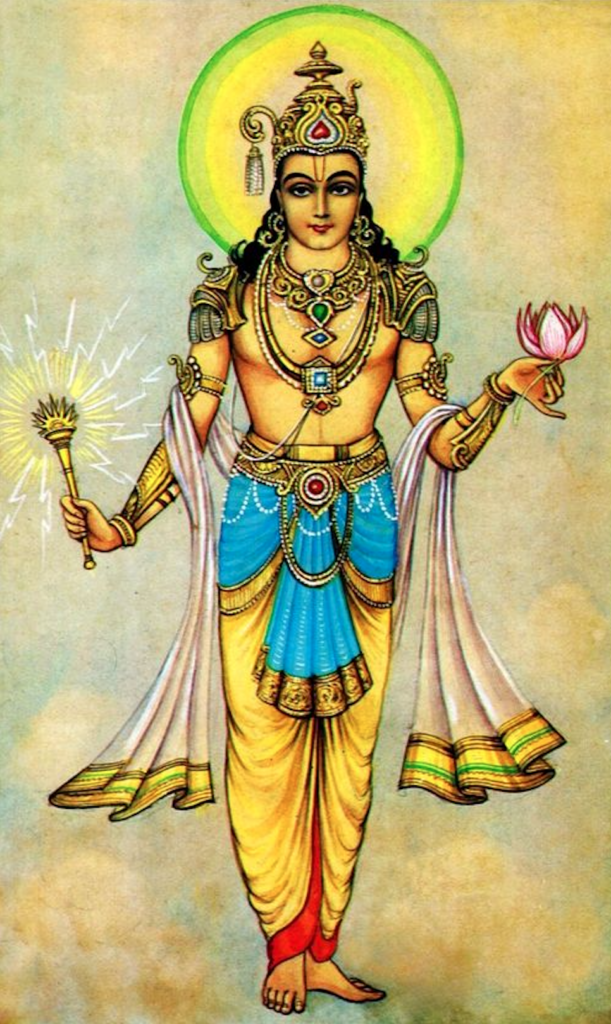
Image: Indra bearing a lotus and the Vajra, Kalyan print, Gita Press
Source: Wikicommons
Indra, the purified discrimination, comprehended Prajapati’s cryptic statement that the Atman, the psychic being, is Brahman. The Asura Virocana took it to mean his outer self.
As Sri Aurobindo puts it, he had mistaken his “vital ego for [him]self; [he] had sought for [his] soul and found only [his] force. For [he] had said, like the Asura, “I am my body, my life, my mind, my temperament,” and become attached with a Titanic force to these; especially [he] had said, “I am my life and my body,” and than that there can be no greater mistake for man or nation. The soul of man…cannot be shut up in a physical, a vital, a mental or a temperamental formula. So to confine it…can only stifle the growth of the inner Reality and end in decay or the extinction that overtakes all that is unplastic and unadaptable.”6
That is the fate that overtakes Daksha, who misinterpreted—like many do today—yogah karmasu kaushalam to mean, “Yoga is skill in action” instead of realising that “to be in yoga is the secret of karma.” Individualism is his chosen creed, the self the deity he celebrates, flying in the face of inexorable Kāla:
In Egypt’s sandy silence, all alone,
Stands a gigantic Leg, which far off throws
The only shadow that the Desert knows.
“I am great Ozymandias,” saith the stone,
“The King of kings: this mighty city shows
The wonders of my hand.” The city’s gone!
Naught but the leg remaining to disclose
The sight of that forgotten Babylon.
We wonder, and some hunter may express
Wonder like ours, when through the wilderness
Where London stood, holding the wolf in chase,
He meets some fragment huge, and stops to guess
What wonderful, but unrecorded, race
Once dwelt in that annihilated place.7
***

As Nolini Kanta Gupta writes, “This imperiousness in man seems however to be a sheer imperviousness: it is a mask, a hollow appearance; for with all his knowledge, at the end he has attained no certainty, no absoluteness…his survey of the universe, his knowledge of boundless Nature and the inexhaustible multiplicities of creation have given him a sense of the endless and the infinite, but he has not the necessary light or capacity to follow those lines of infinity.”8
Titanic9 arrogance overreaches itself and falls on the other side, for ultimately man finds,
All is a speculation or a dream.
~ Savitri, CWSA, Vol. 34, p. 519
In the end the world itself becomes a doubt:
Literally, Daksha loses his head. That is the fate Yajnavalkya warns Gargi of when she persists in questioning him about the nature of the ultimate. That intellect of which man is so inordinately proud incites him into the depths of disaster—nuclear or otherwise. The massive enterprise he has embarked upon lies in ruins; the sky-topping egotism is ground to dust:
The cry of the ego shall be hushed within,
~ Savitri, CWSA, Vol. 34, p. 514
Its lion-roar that claims the world as food,
One of the most puzzling emanations of Sati appears to symbolize this: Chinnamasta, holding her severed head in her hand, drinking the blood spurting from her neck. The head stands for the ego, for it is the mind that expresses individuality. This has been brought to life memorably in Edgar Rice Burroughs’ novel, The Chessmen of Mars, where numerous bodies lie about, rising to act the bidding of the heads that take possession of them. Chinnamasta severs the ego and consumes the vital being to liberate the soul.
***
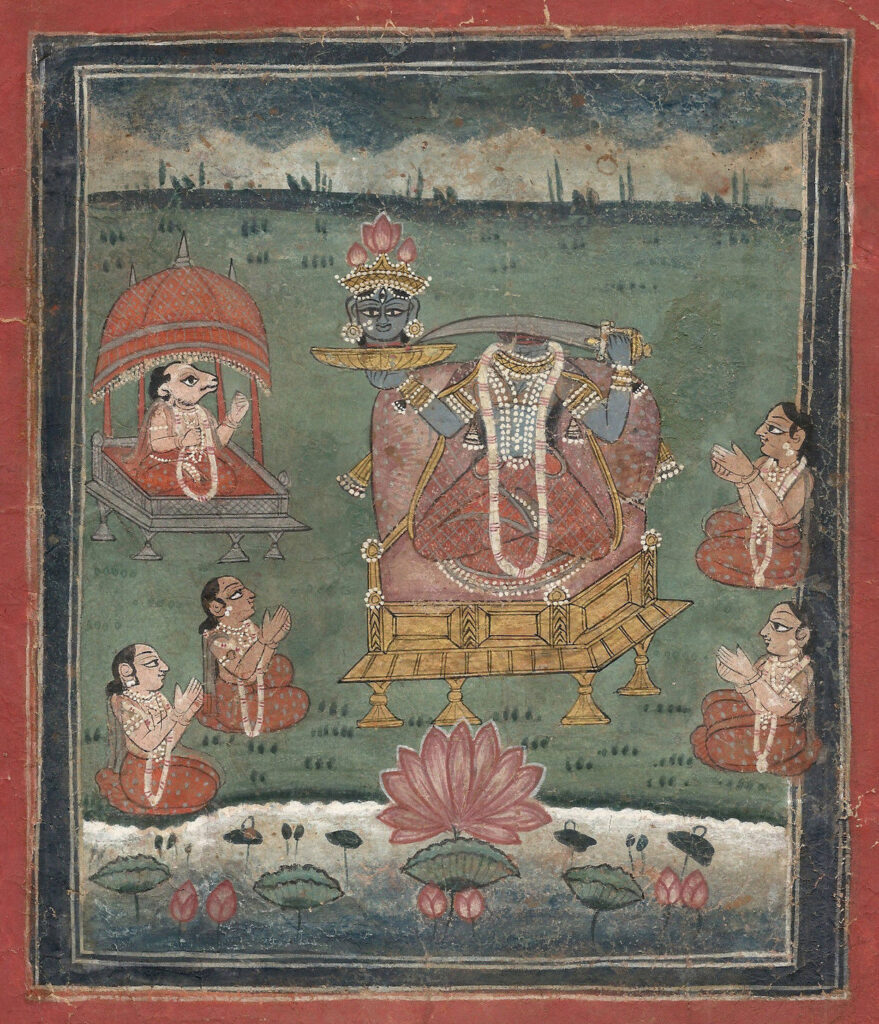
The myth of Daksha does not end with his losing his head—that is precisely its beauty. It looks forward to a renewed existence. What if “the oblivion that succeeds the fall/Had blotted the crowded tablets of the past”? For, “all that was destroyed must be rebuilt.” And so, the decapitated Daksha is given a goat’s head to become Ajamukha— “All can be done if the god-touch is there.” (Savitri, CWSA, Vol. 33, p. 3)
What does this peculiar hybrid form symbolise?
In the Rig Veda (1.1.51) we find that Indra took birth as Savya, son of Rishi Angiras. He ate up the soma plant of sage Medhatithi who called him Mesha (goat) thereafter. Indra, the purified discrimination, consumes the soma-rasa of supernal bliss, ananda. Sri Aurobindo tells us that Angiras is the seer who kindles and tends the flame of aspiration (Agni) for the Divine. Agni’s vehicle is the goat, mesha/aja.
READ:
The Angiras Legend in the Veda
A-ja is the unborn, the eternal. Daksha’s rajaso-tamasic ego is shattered and replaced by Shiva’s grace with the flaming aspiration of the immortal psychic being. Significantly, it all happens in the course of a yajña, the offering up of the lower self to the Supreme Self and the immediate cause is the perverse rejection of the Mother of Light by the human intellect.
After this we do not hear any more of the life of Daksha in the Devi Bhagvata Purana. Instead, we find him re-appearing in the Vishnu Purana as the child of the ten Pracetas rishis and their common wife Marisha, foster-daughter of Soma-Chandra, to father numerous daughters whose offspring populate the world.

Notes and References
- Pradip Bhattacharya, The Secret of the Mahabharata, Parimal Prakashan, Aurangabad, 1984 ↩︎
- No. 8, August 2000 ↩︎
- Ibid., p. 19: “The Legend of Savitri: a mythic background,” talk at Savitri Bhavan on March 12, 2000, reprinted in Mother India ↩︎
- “About Savitri—Part One”, Invocation, No. 6, February 2000, p. 10. ↩︎
- Ibid., p. 11. ↩︎
- Sri Aurobindo, The Human Cycle, CWSA, Vol. 25, p. 42 ↩︎
- Horace Smith composed this sonnet “On a Stupendous Leg of Granite, Discovered Standing by Itself in the Deserts of Egypt, with the Inscription Inserted Below” on 27 December 1817, during an evening of sonnet-writing session with P. B. Shelley. ↩︎
- Nolini Kanta Gupta: “Savitri: an Essay”, Invocation No. 7, April 2000, p. 32 ↩︎
- “Titan” means “overreacher” in Greek. ↩︎

About the Author:
Pradip Bhattacharya has authored and edited 30 books and published numerous articles in India and abroad on Public Administration, Comparative Mythology, Mahabharata, Homeopathy, Management and Human Values. He obtained PhD in Comparative Literature for his research on the Mahabharata, and has been Regional Editor (East) for the Mahabharata Encyclopaedia Project of the Mahabharata Samshodhana Pratishthanam, Bangalore, funded by the Ministry of HRD, Govt. of India. Dr. Bhattacharya initiated a Regional Mahabharata Documentation Project by the Indira Gandhi National Centre of Arts, New Delhi, under the Ministry of Culture.
~ Design: Beloo Mehra

